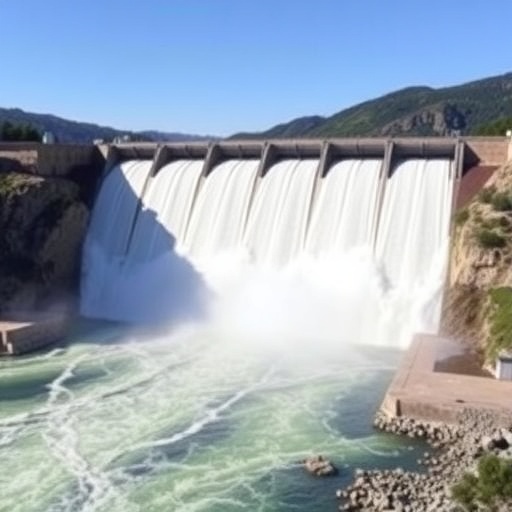The construction of large reservoir dams has become a contentious yet prevalent practice worldwide, primarily due to their ability to provide hydroelectric power, enhance irrigation capacity, and mitigate flooding. However, the repercussions of such significant engineering feats extend beyond just human benefit, particularly in terms of environmental dynamics. Recent research conducted by Babaie, Abghari, and Mostafazadeh sheds light on a pressing issue: the alterations in environmental flow components of permanent rivers resulting from the establishment of these vast reservoirs.
As human civilization continues to expand, the demand for water resources is growing at an unprecedented rate. The rise of large reservoir dams has been viewed as a necessary solution to meet these needs, yet the ecological cost associated with damming rivers cannot be overlooked. The study highlights that permanent rivers, which support diverse ecosystems, may experience profound alterations in their flow characteristics after a dam’s construction. This phenomenon leads to significant ecological shifts, which can influence the health of aquatic and riparian habitats.
The research led by the aforementioned authors dives into the hydraulic dynamics altered by dam-induced reservoir creation. Dams can fundamentally change the flow regime of rivers, transforming areas that were once characterized by seasonal flooding into more stable, controlled aquatic environments. This shift fundamentally restructures the biotic communities that reside in and around these rivers. Flora and fauna that have adapted to historically variable flow patterns may find themselves unable to cope with new conditions, resulting in stark declines in some populations.
One critical aspect the study emphasizes is the concept of environmental flow – the water needed to maintain the health of rivers and the ecosystems they support. Dams often disrupt the natural flow patterns that serve as cues for biological processes like spawning, migration, and habitat formation. For many freshwater species, such as fish, the timing of flow changes can be critical for reproductive success. When these natural cues are muted or eliminated, the health of the population can dwindle, threatening species richness and diversity.
Furthermore, the research articulates how the changes in environmental flow can reach beyond the riverbanks into terrestrial ecosystems. The inundation of land due to reservoir formation often leads to the loss of terrestrial habitats that are crucial for various species. This flooding not only displaces wildlife but also alters the nutrient cycling that sustains these ecosystems. As vegetation is submerged, the organic matter decays at different rates, impacting soil composition and overall ecosystem functionality downstream.
Moreover, the structural integrity of dams poses additional ecological risks. While dams are designed to withstand immense pressures, changes in water levels and unforeseen climatic events can lead to failures. Such scenarios could result in catastrophic flooding downstream, with far-reaching consequences for communities and ecosystems alike. Thus, as the authors of the study point out, it’s essential to adopt a precautionary approach that takes into consideration the potential for structural failure and its environmental ramifications.
The presence of large dams can also introduce new chemical dynamics into river systems, particularly through sediment transport and water quality. The alteration of sediment flow due to dam construction can lead to changes in riverbed morphology and habitat structure. Sediments that would typically nourish downstream ecosystems get trapped in reservoirs, impacting the aquatic habitat’s health. Additionally, slower water flow in reservoirs can create anoxic conditions, altering the chemical composition of the water and potentially leading to harmful algal blooms.
This research adds to a growing body of evidence calling for a re-evaluation of dam projects in light of their environmental implications. Sustainable water management strategies must prioritize ecological health alongside human needs. The findings underscore the importance of maintaining a functional flow regime that can support various life processes within river ecosystems. The authors advocate for integrating ecological assessments into water resource management practices to ensure that both human and ecological requirements are met in a balanced manner.
As debates around large infrastructure projects continue, this study serves as a clarion call for a more nuanced understanding of the trade-offs involved in dam construction. Policymakers, environmentalists, and engineers must work collaboratively to devise solutions that minimize ecological disruption while addressing pressing water resource needs. The path forward should embrace innovative engineering practices that facilitate ecological resilience in an era of rapid climatic and environmental change.
Ultimately, the conclusions drawn from Babaie, Abghari, and Mostafazadeh’s work will inform future dam projects and water management policies. A transformative shift is required in how we approach water resource development, focusing on balance, sustainability, and respect for the natural systems that sustain life. The challenge remains for humanity to harness its ingenuity to ensure that progress does not come at the expense of environmental degradation.
This research exemplifies the complex interplay between human progress and environmental sustainability. As we navigate the challenges of water scarcity and ecological preservation, it’s essential to engage in thoughtful discourse that fully appreciates the implications of our infrastructural choices. A future where ecosystems thrive alongside human settlements is possible, but it requires a commitment to informed and responsible decision-making regarding our river systems.
Subject of Research: The impact of large reservoir dams on permanent river environmental flow components.
Article Title: The changes in environmental flow components of a permanent river due to the construction of a large reservoir dam.
Article References:
Babaie, L., Abghari, H. & Mostafazadeh, R. The changes in environmental flow components of a permanent river due to the construction of a large reservoir dam.
Environ Sci Pollut Res (2025). https://doi.org/10.1007/s11356-025-36822-5
Image Credits: AI Generated
DOI:
Keywords: environmental flow, large reservoirs, ecological impact, water management, biodiversity.




